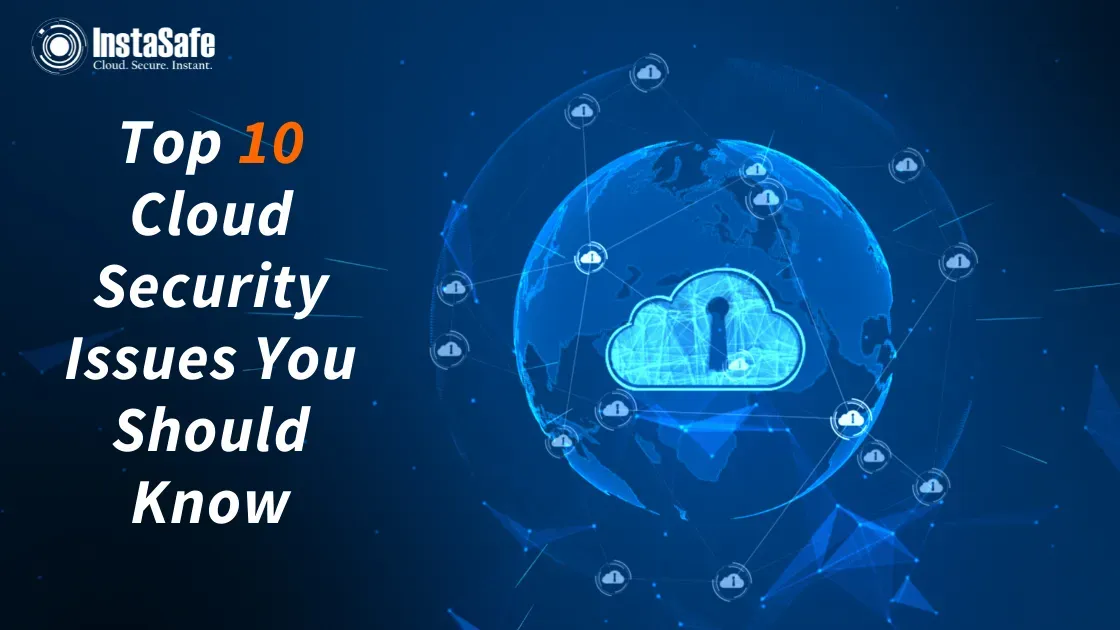Top 10 Cloud Security Issues You Should Know

There has been a remarkable shift in cloud adoption as businesses worldwide move their operations to the cloud. However, you don’t need to believe us—29% of organisations anticipate moving 75% of their workloads to the cloud in the coming months.
However, with the increase in cloud adoption—there has also been an increase in the cloud and cybersecurity threats, including data breaches, ransomware, and other malicious attacks.
According to the 2022 Cloud Security report—94% of organisations are concerned about cloud security at moderate to extreme levels, and 58% of organisations find unauthorised access the biggest security threat.
In this article, we’ll see what the cloud application security issues are and the best solution to combat these risks to ensure a safer cloud and network environment.
Top 10 Cloud Security Risks
The more you rely on the cloud storage and services for your enterprise operations—the more security risks you might face and the more robust your security strategy needs to be.
Here are the potential security threats in cloud services:
Insecure APIs/interfaces
Cloud service providers provide numerous interfaces and application programming interfaces to their organisations that are well-documented so that organisations can access and use them with ease.
However, suppose these interfaces aren’t properly secured—it creates potential risks and issues as cybercriminals can easily use the documentation made for the organisations to access and exploit sensitive data and information in the cloud environment.
Unauthorised access
Any organisation’s cloud-based deployments and operations are present outside the network perimeter and can be easily accessed via the public internet.
While this facilitates accessibility for remote employees, it makes it effortless for attackers to leverage unauthorised access to the cloud resources. To ensure secured data access in the cloud, ensure proper security configurations and strong employee credentials.
Misconfiguration
Misconfigured cloud security settings result in data breaches. Unfortunately, many organisations still rely on traditional security solutions—compromising secure cloud applications and the security posture of the cloud environment.
In most cases, these traditional solutions don’t offer much control to the organisations over cloud security settings—making them rely on the service providers. Moreover, many organisations are unfamiliar with settings—leading to misconfiguration and data breach vulnerabilities.
Lack of visibility
Traditional solutions like VPNs don’t meet the needs of modern enterprises and offer a lack of visibility to the organisations over the network, resource usage, and user activity.
This limits organisations’ ability to monitor their resources and protect them against online attacks.
Account hijacks
Extremely weak password security and easy-to-guess employee passwords are other common cloud security issues.
They result in data breaches and phishing attacks because of weak employee credentials—enabling a single password to be used for several other accounts.
Internal fraud
Malicious insider threats are other significant security issues for organisations.
These malicious internal users already possess unauthorised access to the network and its sensitive resources, making them more difficult to detect—especially with traditional cloud solutions.
External data sharing
Cloud makes data sharing a breeze with external or third-party entities—another major security concern.
The link-based sharing that facilitates collaboration also makes it easier for the attackers to gain access as the link can be forwarded, stolen, and, once compromised, the data cannot be revoked easily.
Cybercriminal attacks
Cybercriminals target specific organisations depending on the expected ransom or profitability they’d receive from the attacks.
Since a cloud-based environment is accessible through the public internet and contains a lot of sensitive data is often improperly secured and configured—resulting in cyberattacks and compromising cloud access security.
DoS attacks
Denial of Service (DoS) attacks are often targeted at a group of organisations and companies that work together collaboratively.
Thus, a successful DoS attack against a cloud infrastructure is likely to impact multiple organisations—allowing attackers to demand high ransom to stop the attack and posing a great deal of threat to their cloud resources.
Abuse of cloud services
Nefarious use of PaaS, SaaS, and IaaS services directly affects cloud customers, organisations, employees, and providers.
Compromises due to brute force attacks, phishing, and click frauds incur expenses, including data loss.
So, how do you ensure the utmost protection against these cloud security issues? The answer is Zero Trust Security.
Zero Trust To Ensure High Cloud Security
Security access to cloud services requires replacing traditional VPN solutions with the robust Zero Trust Secure Cloud Access.
Here are some benefits of Zero Trust to ensure cloud security:
- Offers role-based access controls to the users and employees
- Provides granular-level visibility across the network to monitor network traffic
- Extends on-premise security and seamlessly integrates with compliance and data protection solutions.
- Enhances user experience and ensures fast connections with single-click access.
- Simplifies managing cloud assets from a standard dashboard and eliminates complexities.
- Offers secure cloud access from remote locations.
- Reduces operational expenses.
Conclusion
Cloud provides excellent advantages to the users and employees—facilitating remote resource access, data sharing, and more. However, ensuring high cloud security to combat common security issues is essential to save expenses and prevent data loss.
Check out our Secure Multi-Cloud Access solution—one of the most robust InstaSafe technologies to secure your enterprise cloud infrastructure, ensure simplified cloud access, and improve employee productivity. Get in contact with us at InstaSafe or book a demo today to learn more.
Key Products
MFA | I&AM | ZTNA | Zero Trust Application Access | Secure Enterprise Browser
Key Features
Single Sign On | Endpoint Security | Device Binding | Domain Joining | Always On VPN | Contextual Based Access | Clientless Remote Access | Device Posture Check
Key Solutions
VPN Alternatives | DevOps Security | Cloud Application Security | Secure Remote Access | VoIP Security
